Archive Record
Images
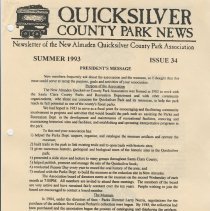
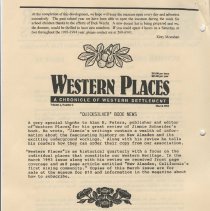
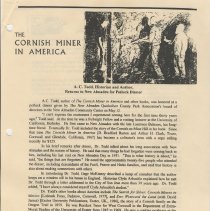

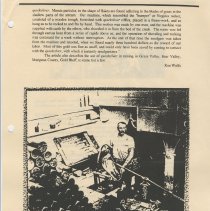

Additional Images [7]
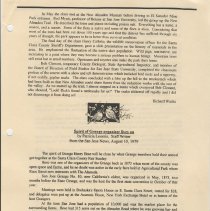
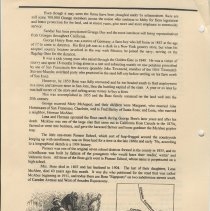
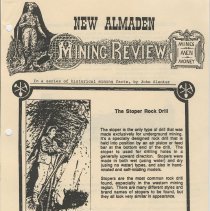
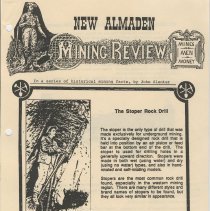

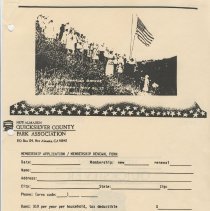
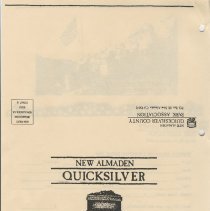
Metadata
Catalog number |
1997.2.2606 |
Object Name |
Newsletter |
Date |
1994 |
Description |
TITLE: Quicksilver County Park News SUBTITLE: Newsletter of the New Almaden Quicksilver County Park Association Issue # 34 Summer 1993 SUMMER 1993 ISSUE 34 PRESIDENT'S MESSAGE New members frequently ask about the association and the museum, so I thought that this issue could serve to recap the purpose, goals and activities of your association. Purpose of the Association The New Almaden Quicksilver County Park Association was formed in 1983 to work with the Santa Clara County Parks and Recreation Department and with other community organizations, who share our concerns for Quicksilver Park and its resources, to help the park reach its full potential as one of the county's finest parks. We had hoped in 1983 to serve as a focal point for encouraging and facilitating community involvement in projects and activities that would benefit the park such as: assisting the Parks and Recreation Dept. in the development and maintenance of recreational facilities, restoring and maintaining historical sites and facilities; and establishing and operating interpretative programs in the park. To this end your association has: 1) helped the Parks Dept. acquire, organize, and catalogue the museum artifacts and operate the museum; 2) built trails in the park to link existing trails and to open trails with historic sites; 3) given numerous historic, geological and biological tours of the historic sites in the Quicksilver park; 4) presented a slide show and lecture to many groups throughout Santa Clara County; 5) helped publish, promote and manage the sale of the Quicksilver book; 6) conducted Pioneer Day every year to record the oral history of the area; and 7) worked with the Parks Dept. to build the museum at the reduction site in New Almaden. The Association board of directors meets at the museum on the second Wednesday of each month at 7:00 PM. All members are invited to attend these meetings. The members of the board are very active and have remained fairly constant over the ten years. People wishing to join the board are encouraged to contact a board member. The Museum In 1984, under the direction of then - Parks Director Larry Norris, negotiations for the purchase of the artifacts from Connie Perham's collection were begun. By 1985, the collection had been purchased and the association began the process of cataloguing and displaying the artifacts. For eight years now your association has maintained the museum and through the efforts of twenty five excellent docents we have kept the museum open to the public. The response to the museum is quite favorable and the docents have been marvelous in presenting our history. The museum is not really publicized at this time due to the fact that we are really busy on Saturdays, the only day that we are open. The fifth phase of the toxic study of the park is coming to an end, and the dirt for the eleven acres where the museum will be built is on its way to cover the toxic ground. At last, 10 years later, we await the first step in the development of the grand entrance to Quicksilver Park. At the completion of this development, we hope will keep the museum open every day and advertise extensively. The past school year we have been able to open the museum during the week for school children thanks to the efforts of Dick Wachs. A new docent list is being prepared and we, the docents, would be thrilled to have new members. If you could spare 4 hours on a Saturday or two throughout the 1993-1994 year, please contact me at 268-6541. Kitty Monahan WESTERN PLACES A CHRONICLE OF WESTERN SETTLEMENT Volume 2, Number 1 March 1993 $10.00 per issue $25.00 per year. "QUICKSILVER" BOOK NEWS A very special thanks to Alan H. Patera, publisher and editor of Western Places; for his great review of Jimmie Schneider's book. He wrote, "Jimmie's writings contain a wealth of information about the fascinating history on New Almaden and its exciting underground workings.' Along with his review he tells his readers how they can order their copy from our association. Western Places is an historical quarterly with a focus on the individual places that constitute our Western Heritage. In the March 1993 issue along with his review we received front page coverage and an8 page article entitled "New Almaden, California's first mining community." Copies of this March issue are for sale at the museum for $10 and information in the magazine about how to subscribe. Calendar of Events Sunday, July 4 - Fireworks viewing. Meet at the Reduction Works at 8:OOPM. Saturday, July 10 - Hiking Club hike. Meet at the Reduction Works at 9:15AM. Saturday, July 17 - Equestrian tide. Meet at the Reduction Works at 9:30AM. Saturday July 24 -Truck Tour (Bass tickets). Meet at the Museum at 9:OOAM.. THE CORNISH MINER 1N AMERICA A. C. Todd, Historian and Author, Returns to New Almaden for Potluck Dinner A.C. Todd, author of The Cornish Miner in America and other books, was honored at a potluck dinner given by The New Almaden Quicksilver County Park Associations board of directors in the New Almaden Community Center on May 12. "I can't express the excitement I experienced coming here for the first time thirty years ago," Todd said. At the time he was a Fulbright Fellow and a visiting lecturer at the University of California, Berkeley. He first came to New Almaden with the late Lawrence Bulmore, his long-time friend. Eventually Dr. Todd included the story of the Cornish on Mine Hill in his book. Since that time The Cornish Miner In America [D. Bradford Burton and Arthur H. Clark, Truro, Cornwall and Glendale, California, 1967] has become a collector's item with a copy selling recently for $125. In his brief remarks after dinner, Dr. Todd talked about his long association with New Almaden and the nature of history. He said that many things he had forgotten were coming back to him, including his last visit on New Almaden Day in 1971. "This is what history is about," he said, "the things that are forgotten." He noted the approximately twenty-five people who attended the dinner, including descendants of the Faull, Pearce and Hicks families, and said that history is also about making connections with others. In introducing Dr. Todd, Gage McKinney described a lump of cinnabar that the author keeps on a window sill in his house in England. Historian Clyde Arbuckle explained how he met Dr. Todd through a letter addressed to the City of San Jose more than 30 years ago. Dr. Todd added, "I have always considered myself Clyde Arbuckle's student." Dr. Todd's other books about America include The Search for Silver: Cornish Miners in Mexico [Lodenek Press, Padstow, Cornwall, 1977], and Ever Westward the Land (with David James) [Exeter University Publications, Exeter, UK., 1986], the story of a Cornish family on the Oregon Trail in 1850. He was Resident Tutor for West Cornwall in the Department of Extra-Mural Studies of the University of Exeter form 1947 to 1969. He was a visiting professor at the University of Arizona and also had teaching assignments in South Africa and Hong Kong. While in California Dr. Todd visited friends and gave the keynote address at the seventh bi-annual gathering of North American Cornish Cousins, an organization of Cornish descendants, in Sacramento. He planned to visit friends in Arizona before returning home in June. At 84, Dr. Todd continues to read and conduct research. He spends part of the year in Slovakia studying the development of mining in central Europe. Gage McKinney Use of Quicksilver in Gold Mining Quicksilver is commonly known as mercury. The description for mercury found in a dictionary is as follows: Symbol Hg - A silvery-white poisonous metallic element, liquid at room temperature. It is used in thermometers, barometers, vapor lamps, and batteries, and in the preparation of chemical pesticides. Atomic number 80; atomic weight 200 59; melting point - n , n. 38`87Ci boiling point 35658C: .specificgravity 13.546; valences 1,2. For those who've often wondered how quicksilver was used in gold mining, some insights can be found in an 1860 issue of Harper's New Monthly Magazine. An article "How we get gold in California" by a Miner of the Year '49 contains several pages describing the use of quicksilver in gold mining. When J. W. Marshall discovered gold at Sutter's Mill in 1848, all the people of California went into the hills to find gold. These were primitive days of mining, as it's machinery had not been invented. At that time gold was found in the crevices of rocks, and dazzled the eye in bright nuggets as it reflected the suns rays. Many gold seekers used no other instrument than a common sheath-knife to pry out the nuggets. Thousands of dollars were collected in this manner. The common washing pan followed. The pan was filled with auriferous (gold bearing) earth, the operator sat or squatted on the edge of a stream, and submerged the load in the water -holding the pan by the rim. The largest stones were thrown out and the flow of water was made to pass constantly around the pan. The load was gradually reduced to a few pebbles or bits of gold, the lighter bits of earth having been thrown over the rim. The remaining fine gold and black sand could not be separated, as they both have the same specific gravity, until the whole was dried in the sun or by a fire, and the sand blown away with the breath. The premise that the superior specific gravity of gold (specific gravity 19.3 - very heavy) over all known metals and minerals underlies the principal of nearly all gold-saving inventions. This is where quicksilver came into the picture. The success of gold mining in California depended upon a constant supply of water, without which the gold was very difficult to separate from the earth. Where water was not available, the miners used "dry washing", which consisted of pounding suspect rocks and earth into the consistency of sand. This was then placed on a sheet of cloth, and the earth tossed to a height of three or four feet. The strong breeze carried away the light dust, while the heavy gold dropped back into the cloth. This was followed by the more practical rocker or "cradle". No one knows who invented the cradle, but it was the means of enriching thousands. This was a wooden box into which earth was thrown to be washed. The cradle was given a rocking motion. The gold thus separated from the earth was captured in its passage by wooden cleats nailed along the bottom, while the lighter materials such as earth and pebbles were washed out the open end of the box. Where the gold was very fine and liable to be carried away by the force of the water, a box containing a quantity of quicksilver was attached to the end of the riffle, where the finer particles were saved by amalgamation. Amalgamation is the process of the dissolving of metal in mercury to form an alloy. Harper's continues, "One of the principle tributaries of the Stanislaus is the stream passing through Morman Gulch, and running within a stone's throw of Tuttletown. The diggings in this vicinity have been celebrated for their richness, especially towards the head of the canon known as Maintain Creek. Desirous of ascertaining if our old diggings had been worked out during our four years of absence, we purchased an old quicksilver machine at this place, which we stationed in a certain bend, half way between Tuttletown and the river. The gold in the bed of this stream is so fine as to escape from the riffles of along tom, and only can be worked to advantage by the use of quicksilver Minute particles, in the shape of flakes are found adhering to the blades of grass in the shallow parts of the stream. Our machine, which resembled the "bumper" or Virginia rocker, consisted of a wooden trough, furnished with quicksilver riffles, placed in a frame-work, and so hung as to be rocked to and fro by hand. This motion was made by one man, and the machine was supplied with earth by the others, who shoveled it in from the bed of the creek The water was led through canvas hose from a series of rapids above us; and the operation of shoveling and rocking was continued for a week without interruption. At the end of that time the amalgam was taken from the machine and retorted, when we found nearly three hundred dollars as the reward of our labor. Most of this gold was fine as snuff, and could only have been saved by coming in contact with the quicksilver, with which it instantly amalgamates." The article also describes the use of quicksilver in mining in Grass Valley, Bear Valley, Mariposa County, Gold Bluff, to name but a few Ron Wolfe New Almaden Quicksilver Mine Course A course to introduce participants to the human and natural history of the New Almaden area was conducted by Bob Clement April 24 - 25 and May 15 - 16. The work was under the auspices of San Jose State University's Field Studies in Natural History division. The first session on the morning of April 24th was conducted by Alan Leventhal who was trained as an archaeologist. He is on the administrative staff at San Jose State University and is a part-time instructor in anthropology at Ohlone College. He has worked with local tribal members to establish their status and to protect their ancient property rights. Leventhal explained that Indians to be eligible for federal grants must prove that they are members of an identifiable group (tribe). The indigenous Californians were scattered among triblets and not easily labeled as identifiable groups. The Bureau of Indian Affairs (BIA) has been slow to react to local claims. Local governments, however, have been cooperative in examining and protecting ancient sites. There are several terms used to describe the local Indians: Mywekma means the people and is probably how the indigenous people of the region identified themselves. Oh(one is the contemporary tern used for the descendants of all the people who lived in the entire bay area. Costanoan was the name given by the Spanish who occupied this region. If progress is t be made in establishing and protecting the rights of the descendants of the indigenous Californians, it will probably be in spite of the Bureau of Indian Affairs not because of it. During the afternoon of that day Peggy Melborne, homemaker, teacher's aid and artist, led a tour of the Hacienda pointing our such landmarks as the Reduction Works, Vichy Springs, St. Anthony Church, the Hacienda graveyard, and the Casa Grande. This was followed by a visit to the New Almaden Museum. The following day, local geologist Michael Cox explained the geology of the New Almaden mining district via a truck caravan. He told us how the region was explored and how mining was performed (hoping and groping). It is an educated guess as to which formations will lead to ore bodies and which will lead to barren rocks. Later that day Kitty Monahan, Quicksilver Association President and educator, showed the class the site of Englishtown and the Civilian Conservation Corps (CCC) camp, where Spanishtown had been, and the location of the red cave where cinnabar was first identified and subsequently mined by Andres Castillero In May the class met at the New Almaden Museum before driving to El Senador Mine Park entrance. Rod Myatt, professor of Botany at San Jose University, led the group up the New Almaden Trail. He described the trees and plants including poison oak Everything has a name, a season, and a reason Some of the flora is native and some of the flora is alien. Considering that most of the trees had been cut down 100 years ago and that the district has suffered through six years of drought, the park appears to be in better than survival condition. The final day of the class Henry Colletto, the wildlife conservation officer for the Santa Clara County Sheriffs Department, gave a slide presentation on the history of mammals in the area. He emphasized the fluctuation of the native deer population. Wild pigs, non-native, are increasing to a point where they may become a serious problem to human beings. Mountain lions still exist but to small numbers. Opossums and coyotes also make the park their home. Bob Clement, temporary County Biologist, State Agricultural Inspector. and member of the Board of Directors of Field Studies for San Jose State University, completed the classroom portion of the course with a show and tell demonstration which included bird nests and a squirmy, if not cuddly, gopher snake. The class concluded with a hike up the hill to the smokestack which had been built so that New Almaden could share fumes from the reduction works with the rest of the valley. As we started up the trail, I almost stepped on a snake which overjoyed Bob Clement, who shouted, "Look! Dick's found a rattlesnake for us!" The snake slithered off rapidly and I did not discourage it from doing so! Richard Wachs Spirit of Grange organizer lives on by Patricia Loomis, Staff Writer from the San Jose News, August 10, 1979 The spirit of George Henry Bole will be close by when Grange members hold their annual get-together at the Santa Clara County Fair Sunday. Bose was one of the organizers of the Grange back in 1873 when most of the county was open space and fame, and he no doubt was active in the early fairs held at Agricultural Park where Race Street now intersects with The Alameda. San Jose Grange No. 10, now Californias oldest, was organized in May, 1873, two months before the State Grange, and was the host for the first state convention in October of that year. Meetings were held in Brohaska's Opera House on E. Santa Clara Street, rented for $28, and delegates were put up at the Auzerais House, New York Exchange Hotel or in homes of the host Grangers. At the time San Jose had a population of 10,000 and was the market place for the surrounding farms. Bole had 315 acres out on the Almaden Road where he was growing hay and raising stock. The area was part of the Pioneer District then and is now called Almaden Valley by the folks who grow lawns and raise a cat or dog. Both Bose and his wife, Mary, were strong supporters of the Grange, which was formed to aid and protect farmers when most Americans tilled the soil. Although to a generation of fairgoers the Grange locally may mean "the best old-fashioned strawberry shortcakes in the whole world," the organization is still a strong political force for agriculture. Even though it may seem the farms have been ploughed under by urbanization, there are still some 700,000 Grange members across the nation who continue to lobby for farm legislation and better protection for the land, and in recent years, give more and more emphasis to community service Sunday has been proclaimed Grange Day and the noon luncheon will bring representatives from Granges throughout California. George Henry Bose was a native of Germany, a farm boy who left home in 1842 at the age of 17 to come to America. His first job was as a clerk in a New York grocery store, but when his adopted country became involved m the war with Mexico, he joined the navy, serving on the flagship Ohio for the duration. It was a sick young man who sailed through the Golden Gate in 1848. He was a victim of scurvy and spent 18 months living alone in a tent and subsisting mainly on raw potatoes prescribed by one of San Francisco's few doctors (possibly John Townsend, member of the 1844 Townsend-Stevens-Murphy overland party who practiced in the sand hill city before settling on his farm north of San Jose). However, by 1850 Rose was fully recovered and he too headed south to find employment in a stove and tinware store in San Jose, then the bustling capital of the state. A year or so later he was half owner of the store and salting away money to buy a farm. This was accomplished in 1855 and the Bose family remained on the land well into the 20th century. George married Mary McAspert, and their children were Margaret, who married John Horstmann of San Francisco; Charlotte, wed to Fred Bailey of Santa Rosa; and Lena, who married a neighbor, Hennum McAbee Lens and Herman operated the Bose ranch during George Bose's later years and after his death. McAbee was one of the large clan that came out to California from Canada in the 1870s, farmed or went into business, and gave the harassed farmer and home gardener the McAbee gopher trap. The little one-room Pioneer School, which sort of leap-frogged around the countryside keeping up with enrollment, was on Bose land for a time in the late 18605 and early'70s, according to a biographical sketch in a 1904 history. Pioneer was one of the original seven school districts formed in the county in 1855, and its schoolhouse was built by fathers of the youngsters who would learn their readin', writin' and 'rithmetic there. All three of the Bose girls went to Pioneer School, whose name is perpetuated on a high school. Mrs. Bose died in 1897 and her husband in 1904. The last of their daughters, Lens McAbee, died 40 years ago this month. It was she who petitioned for the road that was called McAbee beginning in 1911, and today there are Bose "Signposts" on two subdivision streets south of Camden Avenue and West of Almaden Expressway. NEW ALMADEN MINING REVIEW In a series of historical mining facts, by John Slenter The Stoper Rock Drill The stoper is the only type of drill that was made exclusively for underground mining. It is a specially designed rock drill that is held into position by an air piston or feed bar at the bottom end of the drill. The stoper is used for drilling holes in a generally upward direction. Stopers were made in both wet (using water) and dry (using no water) types. And also in hand rotated and self-rotating models. Stopers are the most common rock drill found, especially in the western mining region. There are many different syles and brand names of stopers to be found, but they all look very similar in appearance. Quicksilver, The Complete History of Santa Clara County's New Almaden Mine The New Almaden Quicksilver Mine was the largest, richest mine California has ever known, producing more metallic wealth than any gold mine. It played a major role in the gold and silver bonanzas that opened up the West, and was involved in the most famous land grant case in the country, a case which almost lost California and Nevada to the secessionists in the Civil War. Author Jimmie Schneider was first introduced to the New Almaden Mine in 1910, and ten years later found the town deserted and records, maps and books scattered He began to collect these archives and write the story of New Almaden. The history of the mining operations and the story of the people, their joys and disappointments are recounted in this book. Miners from Mexico and Cornwall worked the vast tunnels and shafts which still riddle the hills. Jimmie Schneider's years of research, exploration, and first-hand experience at mining reach their culmination in thus book. It is the most definitive work to date on the history and workings of the New Almaden Quicksilver Mine, the cornerstone of one of California's most unusual parks. Order Form Please send me copies of the hardbound book, Quicksilver: The Complete History of Santa Clara County's New Almaden Mines at $37.00 each (includes sales tax, shipping and handling). Enclosed is my check for $ Make your checks payable to: NAQCPA. Send your order and check to New Almaden Quicksilver County Park Association P. O. Box 124, New Almaden, CA95092 Name Address City, State, Zip |
People |
Bulmore, Laurence (E.) (Emile) Clement, Bob Coletto, Henry Cox, Michael Leventhal, Alan McKinney, Gage Melbourne, Peggy Monahan, Kitty Myatt, Rod Norris, Larry Perham, Constance (Mrs. Kambish) Todd, Arthur Cecil Wachs, Richard Wolfe, Ron |
Cataloged by |
Meyer, Bob |
